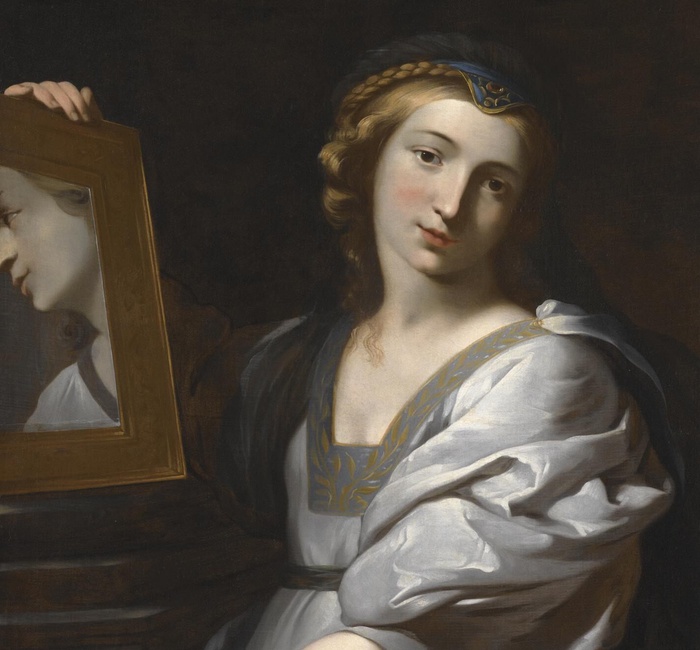
Allegory of Truth by Ginevra Cantofoli has been acquired by the Berkeley Art Museum, University of California at Berkeley. In this painting, a beautiful young woman in a billowing, silvery-blue gown embellished at the neckline with golden brocade holds a balance or pair of scales, standing a mirror offering a reflection of her profile upright on a tower of large books. Owing to the presence of the mirror, the subject of the painting has previously been described as an Allegory of Vanity. Yet it is more likely that the image represents or perhaps meditates upon the idea of Truth.
Similar subjects occur in a number of works by northern Caravaggesque artists in Rome. A painting in the Ashmolean Museum in Oxford, dated around 1620–30, whose attribution has oscillated between various French and Netherlandish protagonists, shows a woman holding a balance and standing a mirror upright on a book, with a skull reflected in the mirror. Another painting, now attributed to the Candlelight Master and dated ca. 1630–33 in the Galleria Nazionale d’Arte Antica, Palazzo Barberini, Rome, deals with the same allegorical subject: the woman holds up a mirror in which books and a lit candle are reflected, and points to a skull placed in front of the mirror, while a balance rests on the table in the foreground.
In the present painting, the scales are not in balance, and rather than a skull, which is totally absent from the composition, it is the woman’s profile that is reflected in the mirror, though it does not quite match that of the protagonist. Such details perhaps suggest that the painting is more than a mere personification of Truth revealing the vanity of the world, but rather contains an allegorical conceit about the nature of art and artifice that would have been apparent to painter and patron. Thus, while the Ashmolean painting and the other related works are generally described as Truth Presenting a Mirror to the Vanities of the World, the present work might be better described as Truth Revealing the Artifice of Art. This kind of sophisticated iconography would have been most appropriate for a discerning and intellectually inclined patron and given its scale would likely have been enjoyed within the confines of a private study or collector’s cabinet.
The Bolognese painter and sometime etcher Ginevra Cantofoli was one of the four women belonging to the Bolognese academy of female painters established by Elisabetta Sirani and was thus part of the wider circle around Guido Reni, the master of Elisabetta’s father Andrea. The female half-length figure of a saint or allegorical personification was one of Reni’s most popular motifs, and indeed, most influential inventions. Cantofoli is the only one of Sirani’s immediate followers to whom a significant surviving oeuvre, of around forty paintings, is ascribed. Early sources attribute six paintings in Bolognese churches to her, noting in three cases that Sirani designed and retouched the works. None of the early writers, including Malvasia, mention private commissions for gallery or cabinet paintings, and the attribution of the present painting and others of this genre, of which there are some thirty-five in number, rely on the Self-Portrait [?] as the Allegory of Painting in the Pinacoteca di Brera, Milan, first ascribed to the artist in 1902.
Recent interest in women artists has led to an increased understanding of the previously neglected oeuvres of painters like Artemisia Gentileschi, Lavinia Fontana, Fede Galizia, and Sofonisba Anguissola. Despite achieving recognition and even great prominence in their own lifetimes, many of their works were given to more prominent male artists after their deaths, and their names fell into obscurity. Their oeuvres are only now being reconstituted, and indeed, Cantofoli, along with the other artists around Sirani, are primed for an imminent rediscovery.